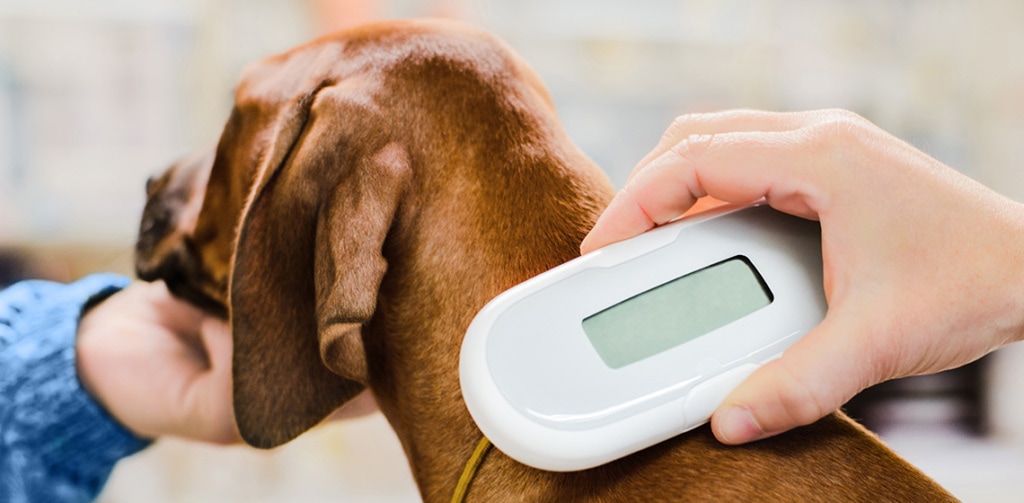It’s every pet parent’s worst nightmare that their beloved, furry friend could get lost, either through running away, escaping from the garden, or even being stolen. So, what can you do as a responsible owner to try to prevent the heartache and turmoil of a lost pet, and help get you reunited as quickly as possible?
Well, microchipping your pet might be the answer. In some countries, microchipping your dog is a legal requirement, and it is also important if you plan to travel abroad with your pet. However, the main benefit of microchipping your dog or cat, is that as long as your details are kept up to date, you have a much better chance of finding and reclaiming your pet, should they go missing.
What is a microchip?
A microchip is a small, electronic device, about the size of a grain of rice. It is implanted under your dog or cat’s skin and emits radio waves when activated by a nearby scanner. These radio waves allow communication of a unique identification number to the scanner, which then displays on the screen. This unique number can then be looked up on the online or telephone database, and the owner details found.
How is a microchip implanted?
Implanting a microchip is a quick and relatively easy procedure for those who have had the necessary training. Normally, a microchip can be implanted conscious, with no need for sedation or an anesthetic. A needle is used that is just large enough to contain the microchip and, with the skin of the scruff lifted, the needle is inserted through the skin into the space below. The needle is then plunged to administer the microchip before the needle is removed.
Occasionally the area can bleed for a short time afterward, but it is rare to see any complications and it is not a particularly painful procedure. Once the chip is implanted, a scanner is used to check that the microchip is working correctly.
Does a microchip allow tracking? Or invade my privacy in any way?
The microchip itself is not a GPS tracker, nor can it ‘listen in’ on you or your family. In fact, a microchip doesn’t do anything at all unless a scanner is being used nearby, and even then, the only information it transmits is its unique identification number.
My dog wears a collar and an ID tag, isn’t that enough?
Although it is a very good idea to have your pet wear a collar and identification tag, this is not a substitute for microchipping. If your pet were to get lost, a collar may fall off, leaving your pet unidentifiable. Similarly, with pet theft on the rise, it’s important to remember that any pet thief could easily remove a collar and tag.
How do I find out if my pet is already microchipped? Who can scan for a microchip?
If you adopted your dog or cat from a rescue center, or you’re unsure if the breeder microchipped your pet, you could take them to your local veterinary clinic where a member of staff will be able to check. However, make sure you phone ahead so that they can give you a convenient time to pop in! Many other people who work closely with animals also have microchip scanners, including dog wardens, animal control, animal welfare officers, and some rescue shelters or animal charity workers.
How do I find out if a found dog or cat has a microchip?
If you have found a dog or cat and they seem healthy, do not automatically assume that they are lost. If they are in no obvious danger, a paper collar can be used to try to find out if they are truly lost or just roaming. You can write on the collar that you think they may be lost, and provide your contact details so that, if they do have a home, their owner can call to reassure you.
If the pet seems unwell, injured, or in danger, or if there is no response to the paper collar, you can contact your local veterinary clinic or animal control, and they will be able to use a scanner to check for a chip.
Where can I get my dog microchipped?
Veterinary clinics are perhaps the most obvious place to get your pet microchipped, and you can find a list of veterinary clinics in your area, here. There are also trained microchip implanters, who aren’t veterinary trained, just make sure that you are confident that they have the necessary qualifications.
How much does it cost to microchip a dog?
Although prices will vary between clinics, the average price of getting a dog microchipped is $40 – $50. This covers the cost of the chip as well as the implantation procedure
Chip your pet month
May is ‘Chip your pet month’, which serves as an annual reminder not just to ensure that all of your pets are microchipped, but also to make sure that the details associated with the chip are up to date. Because ‘Chip your pet month’ is a national effort to increase awareness of the importance of microchipping your pets, some veterinary clinics and services, including The Vets, will offer reduced price microchipping during the month, so it’s worth keeping an eye out for deals.
So, why is it important to microchip your pet?
As long as the contact details are kept up to date, microchipping your pet drastically improves your chances of being reunited with your canine companion or feline friend. The sad fact is that pet theft is increasing, so it’s reassuring to know that anyone scanning your stolen pet will know that they are not with their rightful owner.
Ultimately, we all want the best for our fur babies, so it’s definitely worth microchipping your pet for added peace of mind.

Dr. Hannah Godfrey MRCVS graduated from the Royal Veterinary College in 2011. Although she initially worked in mixed practice treating all species, she found a love for small animal work and has worked exclusively with dogs and cats since 2014. She lives in Wales with her partner, son, and two cats (named Poppy and Ashton Kutcher), and writes comedy fiction in her spare time.








